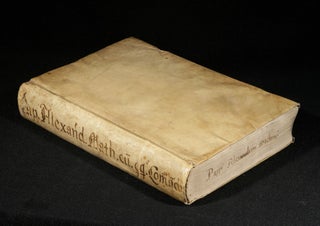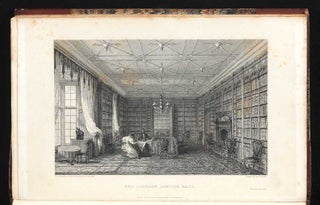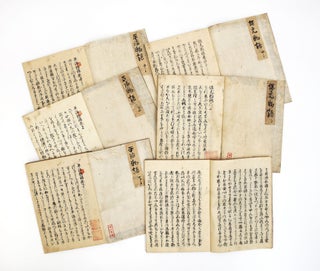The Essential Japanese Dictionary;
“Ekirin Bon” Edition
Setsuyoshu 節用集 [Convenient & Useful Dictionary]. Compiled & published by Ekirin Hirai.
Seven columns of text per page. 68; 72 folding leaves. Two vols. Large 8vo (285 x 206 mm.), orig. (or very early) dark thick wrappers (strengthened & with new endpapers), new stitching. From the colophon: Kyoto: Ekirin Hirai, 1597.
The setsuyoshu, the essential Japanese dictionary, “one of the mainstays of the publishing industry and…probably the most likely book to be found in a house of few books.”–Kornicki, The Book in Japan, p. 248. Widely used from the 15th century through the early Meiji period; there were more than 500 editions in many styles and formats, and many with additions. All early editions are extremely rare, as they were used to death. We find no 15th- or 16th-century edition of the setsuyoshu in WorldCat.
Anonymously compiled sometime in the second half of the 15th century, setsuyoshu was originally a dictionary used for looking up Chinese characters using the Japanese reading of that character or word. Through the 16th century, it remained a Japanese language dictionary of characters appropriate to the vocabulary popular in Muromachi times, with occasional word commentary and etymological explanation.
The earliest setsuyoshu (kohon setsuyoshu or “old-style” setsuyoshu), are divided into three main categories, based on the first word listed in the dictionary: the earliest, Ise (the old name for Mie prefecture), and two offshoots: Indo (India) and Inui (northwest). Our edition — the so-called “Ekirin” edition, compiled and published by Ekirin (or Kyuyo or Katsuzaemon) Hirai — is the first edition of the Inui category. It is the first setsuyoshu whose author we can identify with certainty and became the model for all later Edo editions of the setsuyoshu dictionaries.
Ekirin Hirai was a samurai who entered the nascent world of commercial publishing in Kyoto. He was engaged by the Nishi hongan ji (temple) of Kyoto to publish its Buddhist texts.
The audience for the kohon setsuyoshu was the literate elite, and they used the dictionary mainly for artistic pursuits. By the late 17th century, the setsuyoshu developed from its initial dictionary form into a household encyclopedia with additional text containing useful knowledge for daily life.
Fresh set. Some worming throughout, mostly marginal and carefully repaired. Preserved in a chitsu.
❧ Don Clifford Bailey, “Early Japanese Lexicography” in Monumenta Nipponica, Vol. 16, Nos. 1/2 (1960), pp. 1-52. Steffen Remvik, Setsuyoshu in Early Modern Japan: A Book Historical Approach, PhD dissertation, January 2017 (online).
Price: $25,000.00
Item ID: 7017

![Item ID: 7017 Setsuyoshu 節用集 [Convenient & Useful Dictionary]. Compiled & published by Ekirin Hirai. EKIRIN BON.](https://jonathanahill.cdn.bibliopolis.com/pictures/7017.jpg?width=768&height=1000&fit=bounds&auto=webp&v=1588722733)
![Setsuyoshu 節用集 [Convenient & Useful Dictionary]. Compiled & published by Ekirin Hirai.](https://jonathanahill.cdn.bibliopolis.com/pictures/7017_2.jpg?width=320&height=427&fit=bounds&auto=webp&v=1588722733)
![Setsuyoshu 節用集 [Convenient & Useful Dictionary]. Compiled & published by Ekirin Hirai.](https://jonathanahill.cdn.bibliopolis.com/pictures/7017_3.jpg?width=320&height=427&fit=bounds&auto=webp&v=1588722733)



